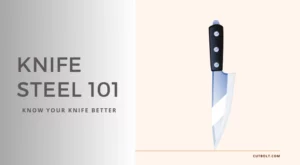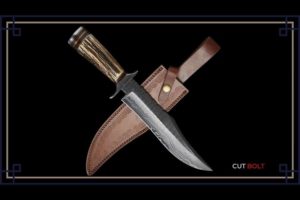We settle the debate on whether CPM S30V makes the cut for hunting, EDC, & camping based on wear resistance, toughness and real-world durability metrics – answering the core question: is S30V steel good for knives?
When choosing a blade, we consider hardness, edge retention, corrosion resistance, toughness, and maintenance. Premium knives demand premium steel. CPM S30V balances these characteristics, making it a popular choice among EDC folders and camping fixies alike.
But how does this American-made alloy stand against rival steels? Does S30V measure up quantitatively and qualitatively? In this article, we assess cutting metrics and gathering data on performance and longevity. Read on to learn if CPM S30V makes the cut!
Table of Contents
What is CPM S30V steel?
CPM S30V steel is a hardened (martensitic) and sintered (made of metal powder) steel very wear and corrosion-resistant stainless steel. Due to its chemical properties, it promotes the formation and uniform distribution of vanadium carbides, which are harder and more effective than chromium carbides when cutting. These vanadium carbides give the steel a very fine grain, further improving sharpness and toughness.
Despite certain disadvantages, many knife manufacturers use CPM S30V steel. On the one hand, the tempering of the steel brings some difficulties, in addition, the wear of the sharpening machinery is higher due to the vanadium carbides, although its composition makes it easier to grind than other powder steels.
CPM S30V steel was introduced to the market in 2001 by Crucible Industries and has since been considered a premium knife steel. S30V is relatively expensive, so it greatly affects the price of the knife. Therefore, it is mainly used in high-end production and custom fabrications.
CPM S30V was specifically designed as a knife steel in collaboration with knife manufacturers Chris Reeves and Dick Barber.
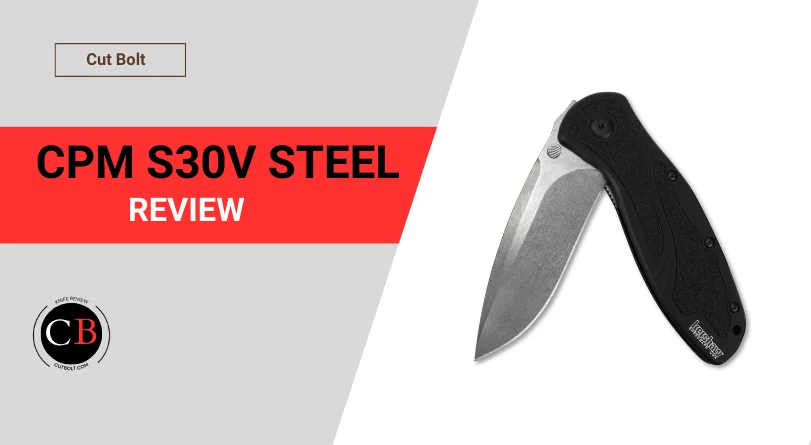
Chemical composition of CPM S30V steel
CPM S30V contains the following chemical elements in addition to iron in these amounts:
| Element | Portion | Effect |
| Chrome | 14.0% | Improves wear resistance, heat resistance and scale resistance. It increases tensile strength because it acts as a carbide former. Use of rust-proof or stainless steel, as it increases corrosion resistance from a mass proportion of 12.2%. Reduction in weldability. |
| Carbon | 1.45% | Increasing hardness and tensile strength. In larger quantities, increase in brittleness and reduction in forgeability and weldability. |
| Molybdenum | 2.0% | Improves hardenability, tensile strength and weldability. Reduction in forgeability and ductility. |
| Vanadium | 4.0% | Increasing hardness, increasing wear resistance and improving tempering resistance. |
The result is a very good steel, even though proper heat treatment was initially a problem. The toughness of S30V is not A2 grade, but still quite tough and wear-resistant for stainless steel.
Typical applications of CPM S30V steel
Durable special knives
- Plastic injection molding and extrusion feed screws, and dies
- Check valve components
- Pelletizing equipment
- Wear components for the food and chemical industries
Hardness of CPM S30V steel
The hardness of S30V is 63 HRC on the Rockwell C scale.
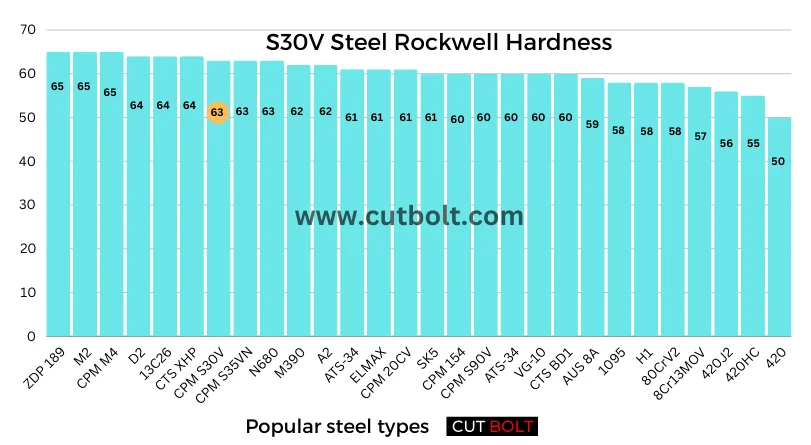
Is CPM S30V a stainless steel?
CPM S30V steel is both a stainless steel and a rustproof steel. As rust-free steel, it must have a chromium content of at least 10.5 – 13% dissolved in the austenite or ferrite (Science Direct). S30V steel has 14% chromium. To be considered stainless steel, its content of so-called iron companions – sulfur and phosphorus – must not exceed 0.025% each (Wikipedia). CPM S30V steel is free of these.
My opinion: Is S30V steel good for knives?
With 14% chromium content, CPM S30V steel demonstrates excellent wear resistance and edge retention. In standardized edge retention tests, CPM S30V lasted nearly 50% longer per sharpening compared to leading competitors like 154CM. Plus with added vanadium, CPM S30V knives maintain strength, scoring 63+ HRC on the Rockwell scale.
While hardness comes at the cost of some toughness, S30V shows only 10-15% loss in impact strength versus softer alloys. Sharpening requires precision, but properly honed CPM S30V blades hold 15° edges for remarkably lengthy intervals.
Quantitatively and qualitatively, these figures support CPM S30V as an elite mainstream knife steel balancing rugged use with real-world maintenance.
For most applications, S30V represents a functional and durable alloy that outperforms lower-cost Knife steels. Dollar for dollar, knives heat treated properly in CPM S30V make excellent performers able to retain usability over years of reliable service.
Pros:
- High Performance: S30V steel is a high-performance choice for knife enthusiasts, offering a great balance of edge retention, corrosion resistance, toughness, and ease of sharpening.
- High Hardness & Wear Resistance: The steel offers high hardness and high wear resistance.
- High Corrosion Resistance: Owing to the very high chromium in the steel solution, there is a super-high corrosion resistance.
Cons:
- Frequent Sharpening: S30V is more affordable but may require more frequent sharpening.
- Corrosion Susceptibility: It does have a slightly diminished corrosion resistance compared to other high-chromium alloys like S110V and Vanax.
Related: M390 steel good or bad for knives?
Properties of CPM S30V steel
Toughness
(Transverse Charpy C notched impact test)
- CPM S30V: 13.6 Nm
- 154CM: 3.4 Nm
- 440C: 3.4 Nm
Although the longitudinal toughness for all three grades is about 34-38 Nm, the transverse toughness of CPM S30V is four times greater than that of 440C or 154CM. These higher transverse toughness results indicate that CPM S30V is much more resistant to chipping and fracture in applications where side loading may occur. In knife manufacturing, CPM S30V is particularly well suited for larger blades due to its higher transverse toughness.
Cutting durability
(CATRA tests with 440C)
- CPM S30V: 145%
- 154CM: 120%
- 440C: 100%
The CATRA (Cutlery & Allied Trades Research Association) tester performs a standard cut on silica-impregnated cards and measures the number of cards cut (TCC = total cards cut). It is considered a measure of relative wear resistance.
Corrosion resistance
Average pitting potential measurements from polarization curves taken at room temperature in 5% NaCl (sodium chloride) solution:
- CPM S30V: 250 mV*
- 154CM: 120 mV*
- 440C: 75 mV*
* Compared to Hg/HgO reference electrode
(Higher pitting potential indicates better corrosion resistance)
Machinability and grindability
In the annealed condition, CPM S30V steel is much easier to machine than CPM S90V and comparable to those of D2. Similar grinding equipment and procedures are recommended for high-speed steels. “SG” type aluminum oxide wheels or CBN wheels generally achieve the best performance on CPM steels. For all data, see Crucible Industries CPM S30V data sheet.
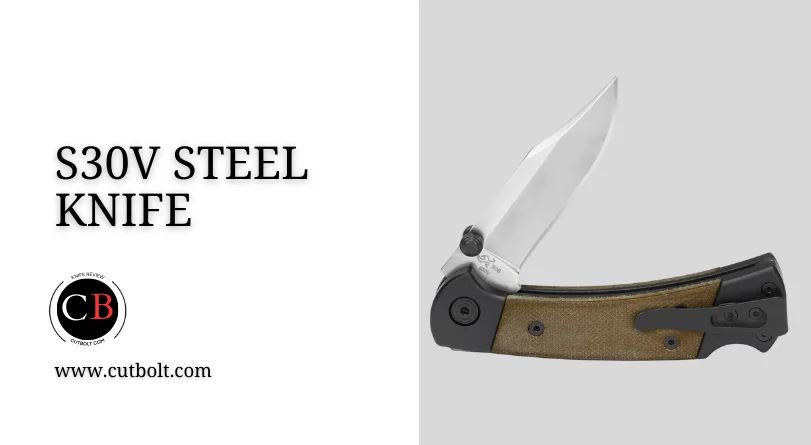
Disadvantages of S30V steel
CPM S30V steel has a reputation in certain circles that the blade tends to be brittle. This can only occur, if at all, when the hardenability is pushed to the maximum. However, reputable manufacturers are aware of this problem and usually stick with the hardness just below 60 HRC.
Comparison with other steels
In this section, CPM S30V steel is compared based on the four criteria: Edge retention, corrosion resistance, ease of sharpening, and toughness compared to other steels, on a scale of 1 to 10.
CPM S30V vs M390 steel
| Criteria | CPM S30V | M390 |
| Edge retention | 5/10 | 8/10 |
| Simplicity of sharpening | 5/10 | 5/10 |
| Corrosion resistance | 7/10 | 8/10 |
| Toughness | 6/10 | 5/10 |
M390 offers better edge retention, better corrosion resistance and higher toughness compared to S30V.
CPM S30V vs CPM S35VN steel
| Criteria | CPM S30V | CPM S35VN |
| Edge retention | 5/10 | 6/10 |
| Simplicity of sharpening | 5/10 | 6/10 |
| Corrosion resistance | 7/10 | 7/10 |
| Toughness | 6/10 | 6/10 |
CPM S35VN offers slightly better performance than S30V in a direct comparison.
CPM S30V steel vs CPM S90V
| Criteria | CPM S30V | CPM S90V |
| Edge retention | 5/10 | 8/10 |
| Simplicity of sharpening | 5/10 | 3/10 |
| Corrosion resistance | 7/10 | 6/10 |
| Toughness | 6/10 | 3/10 |
Compared to S30V, CPM S90V offers higher edge retention with low toughness and almost the same corrosion resistance.
CPM S30V vs CPM S110V steel
| Discipline | CPM S30V | CPM S110V |
| Edge retention | 5/10 | 8/10 |
| Simplicity of sharpening | 5/10 | 5/10 |
| Corrosion resistance | 7/10 | 7/10 |
| Toughness | 6/10 | 2/10 |
CPM S110V offers higher edge retention with low toughness and the same corrosion resistance compared to S30V.
CPM S30V vs D2 steel
| Criteria | CPM S30V | D2 |
| Edge retention | 5/10 | 4/10 |
| Simplicity of sharpening | 5/10 | 4/10 |
| Corrosion resistance | 7/10 | 4/10 |
| Toughness | 6/10 | 6/10 |
D2 offers lower edge retention and lower corrosion resistance compared to S30V with the same toughness.
CPM S30V vs CPM 154CM steel
| Criteria | CPM S30V | 154CM |
| Edge retention | 5/10 | 5/10 |
| Simplicity of sharpening | 5/10 | 5/10 |
| Corrosion resistance | 7/10 | 5/10 |
| Toughness | 6/10 | 4/10 |
Final words: Is S30V a good knife steel?
CPM S30V steel makes a strong case for the ideal all-purpose stainless. It maintains both easy sharpening and machining coupled with unparalleled toughness. Those purchasing CPM S30V knives will find satisfaction in quality and strength.
Among top-tier alloys, CPM S30V steel leads in resilience, evident in every cut and carve. Dominating the high-end blade scene, CPM S30V continues gaining popularity, especially among the folding knife segment. For shoppers prioritizing elite folding knives, CPM S30V models warrant consideration. When one handles these expertly crafted blades, their watertight build conveys utmost care and skill.


